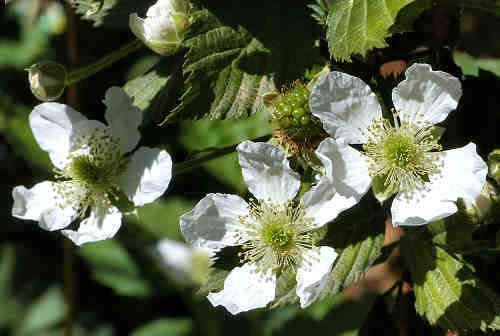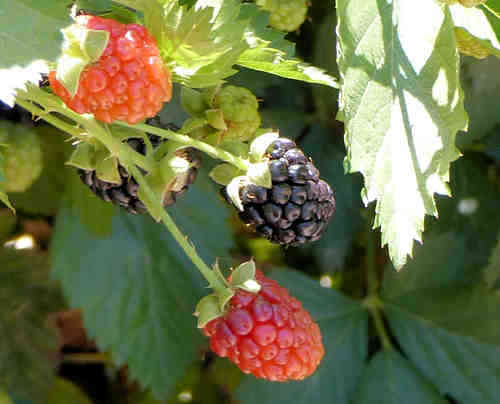Growing Blackberries and Boysenberries:
Rubus species
Back to Fruit, Berries and Nuts
Botanical Overview
A Rose family member, the Rubus genus has over 250 species. Commercial blackberries in North America are hybrids of several blackberry species.
Description
Form:
A bramble, composed of canes growing from a root crown.
Lifespan:
Productive for 15-20 years.
Leaf retention:
Deciduous.
Growth rate:
Rapid.
Mature Size:
10' (3m) high and as wide.
Flowers:
White, five petals.
Bloom:
Late winter to early spring.
Self-fruitful:
Yes.
Years before fruiting:
0-1.
Fruit:
The "berry" is an aggregate fruit, with many small round fruit clustered together, connected
to a center part called the torus. The seeds are relatively large.
Months for fruit to ripen:
1-1.5, depending on cultivar. The berries are ripe when fully black. They are sweetest
when they turn from glossy black to dull black. Blackberries do not ripen if picked unripe.
Storage after harvest:
Blackberries can be refrigerated up to 7 days, but then must be eaten, cooked or frozen.
Leaves: Dark green, fuzzy, toothed edges, with small
spines underneath.
Stems: Blackberry canes fall into four groups based
on whether they are thorny or thornless, and erect or trailing. Erect canes are somewhat
self-supporting while trailing canes need to be trellised. The first year canes (primocanes)
produce leaves with no flowers or fruit.
Second year canes (floricanes), produce flowers and fruit on their lateral branches.
A few cultivars, however do produce flowers in the fall on the top one-third of their
first-year canes. These primocane-blooming cultivars do not as yet perform well in high
temperature regions.
Roots:
Shallow, spread by rhizomes, invasive in moist areas, but sensitive to heat in USDA zones
8 and up.
Cultivars of Note for hot regions:
'Boysenberry Thornless' trailing canes needing
support, very large, fragile, purple fruit, few seeds, USDA zones 5-10.
'Navaho' erect canes, thornless, small to medium
sized, sweeter fruit with smaller seeds, very heat and drought tolerant, USDA zones 6-10.
'Triple Crown' semi-trailing canes, thornless,
medium-sized fruit, very productive, USDA Zones 5-10.
Wildlife:
The flowers attract bees. Birds and small mammals eat the fruit.
Blackberries are caterpillar host plants for the Blackberry Looper moth. Rabbits also like to
eat the canes and bark, so this plant may need a rabbit-proof enclosure.
Toxic / Danger:
Many cultivars are thorny to very thorny.
Origin:
Northern Hemisphere non-desert regions in Asia, Europe, and North America.


Cultivation and Uses
USDA hardiness zones:
5-10 or 6-9 for cultivars suitable for hot dry climates.
Chill hours:
Plants needing 100-300 chill hours are best in USDA hardiness zones 8-10. Many cultivars found
in nurseries need 500-1000 chill hours and do not flower or set fruit in warm winter regions.
Heat tolerant:
Part shade, especially in the afternoon, is needed when temperatures exceed 85°F
(29.4°C).
Drought tolerant:
Depends on cultivar.
Sun:
Light or sprinkled morning sun with sprinkled to full afternoon shade in temperatures over
85°F (29.4°C). Afternoon shade is required.
Planting:
Locate blackberry plants where they will receive part shade throughout the day,
in a bare soil area with no grass or ground cover closer than 4' (1.2m) from the plant.
Planting on the east side of a west-facing, 6' (1.8m) high wall is a frequent choice.
Avoid low areas where freezing winter air can pool and damage crops.
With more than one plant, place them 3-4' (1-1.2m) apart.
In USDA zone 9 and up, plant in the fall instead of winter or spring. Summer heat will inhibit root formation.
All canes are easier to harvest if they are held in a fan-shaped arrangement off the ground by horizontal wires between posts.
In USDA zone 9 and up, plant in the fall instead of winter or spring. Summer heat will inhibit root formation.
All canes are easier to harvest if they are held in a fan-shaped arrangement off the ground by horizontal wires between posts.
Soil:
Well draining, with pH 5.1-7.5 (strongly acidic to neutral). Place in a hole at least 1' (0.3m)
deep, with a 4' (1.2m) diameter, containing 20% organic material.
Fertilize:
Use an organic fertilizer, spread in a 3' (1m) radius around the plant, in late winter and
again in early summer.
Water after becoming established:
Every two weeks without berries, once a week during berry production. Water evenly in a circle
around the base of the plant up to a 4' (1.2m) radius.
Blackberry roots are shallow, not deep.
The plant needs water twice a week in temperatures over 100°F (38°C) or the canes
will die back to the roots. It will recover from its roots when rain begins.
Mulch:
Apply organic material in a 4' (1.2m) radius around the plant base to reduce heat stress and
water loss in the root area.
First Year Care:
Frequent watering is critical to establish an extensive root system.
Pruning and Weeding:
Remove suckers more than 2' (0.6m) from the base of the plant.
In the summer, using pruning shears, trim off the last 4" (10cm) of primocanes to encourage
side branching and more flowers.
After harvest, cut the second year canes that have just produced fruit to the ground.
Remove weeds and grass, which compete for nutrients, by hand to avoid damage to shallow roots. No other vegetation, especially grass, should be growing within 4' (1.2m) of the base of the plant.
After harvest, cut the second year canes that have just produced fruit to the ground.
Remove weeds and grass, which compete for nutrients, by hand to avoid damage to shallow roots. No other vegetation, especially grass, should be growing within 4' (1.2m) of the base of the plant.
Litter:
Low.
Propagation:
Tip layering, new suckers (primocanes) cut from rhizomes, seed. Seed will sometimes breed
true, but not always. Seed is viable when dried and requires scarification before
stratification.
Pests:
Blackberries are very susceptible to Verticillium wilt. Avoid planting them in soils where
previous plants had that disease. Nightshade family members and some rose family members
are susceptible, so avoid soils where they have grown.
Uses: Edible fruit.
Do you have additional information or a different experience for these plants that you would like to share? Email info@GardenOracle.com. All contributions are welcome and appreciated.
Latest update: February, 2024
© 2008-2025 by GardenOracle.com

